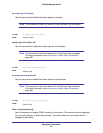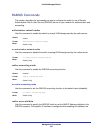
Management Commands
695
ProSafe Managed Switch
RADIUS client uses that IP address while sending NAS-IP-Address attribute in RADIUS
communication.
Format radius server attribute <4> [<ipaddr>]
Mode
no radius server attribute
Use the
no version of this command to disable the NAS-IP-Address attribute global
parameter for RADIUS client. When this parameter is disabled, the RADIUS client does not
send the NAS-IP-Address attribute in RADIUS requests.
Format no radius server attribute <4> [<ipaddr>]
Mode
The following shows an example of the command.
(Switch) (Config) #radius server attribute 4 192.168.37.60
(Switch) (Config) #radius server attribute 4
radius server host
Use this command to configure the IP address or DNS name to use for communicating with
the RADIUS server of a selected server type. While configuring the IP address or DNS name
for the authenticating or accounting servers, you can also configure the port number and
server name. If the authenticating and accounting servers are configured without a name, the
command uses the ‘Default_RADIUS_Auth_Server’ and ‘Default_RADIUS_Acct_Server’ as
the default names, respectively. The same name can be configured for more than one
authenticating servers and the name should be unique for accounting servers. The RADIUS
client allows the configuration of a maximum 32 authenticating and accounting servers.
If you use the <auth> parameter, the command configures the IP address or hostname to
use to connect to a RADIUS authentication server. You can configure up to 3 servers per
RADIUS client. If the maximum number of configured servers is reached, the command fails
until you remove one of the servers by issuing the “no” form of the command. If you use the
optional <port> parameter, the command configures the UDP port number to use when
connecting to the configured RADIUS server. The <port> number range is 1 - 65535, with
1812 being the default value.
Global Config
Term Definition
4
NAS-IP-Address attribute to be used in RADIUS requests.
ipaddr
The IP address of the server.
Global Config


















